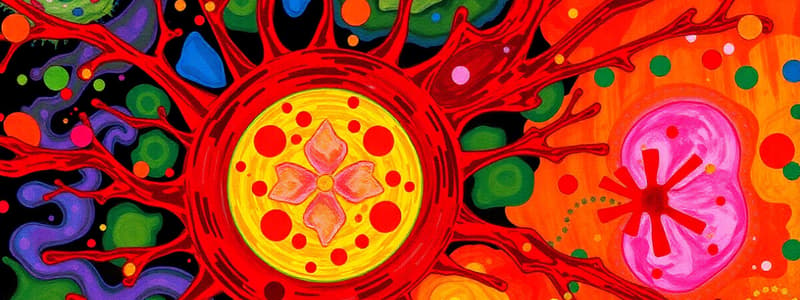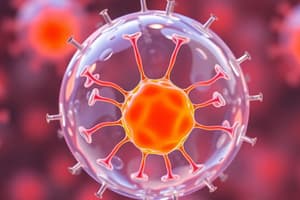Podcast
Questions and Answers
What type of cellular change is characterized by disrupted cell size, shape, and organization, often associated with cancer precursors?
What type of cellular change is characterized by disrupted cell size, shape, and organization, often associated with cancer precursors?
- Metaplasia
- Dysplasia (correct)
- Hypoplasia
- Hypertrophy
Which condition describes incomplete development of an organ with reduced cell numbers?
Which condition describes incomplete development of an organ with reduced cell numbers?
- Hypoplasia (correct)
- Hyperplasia
- Metaplasia
- Dysplasia
Which type of cellular adaptation involves the transformation of normal columnar epithelium to squamous epithelium?
Which type of cellular adaptation involves the transformation of normal columnar epithelium to squamous epithelium?
- Dysplasia
- Metaplasia (correct)
- Hypoplasia
- Atrophy
What characterizes hyaline change in tissue samples stained with H&E?
What characterizes hyaline change in tissue samples stained with H&E?
Which of the following statements about dysplasia is true?
Which of the following statements about dysplasia is true?
What characterizes adaptations in cells?
What characterizes adaptations in cells?
Which of the following is NOT a type of adaptive response?
Which of the following is NOT a type of adaptive response?
What does 'atrophy' refer to?
What does 'atrophy' refer to?
Which of the following could lead to muscular atrophy?
Which of the following could lead to muscular atrophy?
Ischemia can cause brain atrophy as part of which phenomenon?
Ischemia can cause brain atrophy as part of which phenomenon?
Which condition is primarily associated with loss of nerve supply leading to atrophy?
Which condition is primarily associated with loss of nerve supply leading to atrophy?
What is the impact of eliminating the stress causing cell adaptation?
What is the impact of eliminating the stress causing cell adaptation?
Which of the following is a cause of atrophy related to nutritional status?
Which of the following is a cause of atrophy related to nutritional status?
What type of cells undergo profound hyperplastic growth?
What type of cells undergo profound hyperplastic growth?
Which of the following is NOT a type of hyperplasia?
Which of the following is NOT a type of hyperplasia?
What primarily drives hyperplasia?
What primarily drives hyperplasia?
Which of the following is an example of physiological hyperplasia?
Which of the following is an example of physiological hyperplasia?
Which cells typically have no capacity for hyperplasia?
Which cells typically have no capacity for hyperplasia?
What is metaplasia?
What is metaplasia?
Endometrial hyperplasia is primarily caused by which factor?
Endometrial hyperplasia is primarily caused by which factor?
Squamous metaplasia of the respiratory epithelium is often a result of:
Squamous metaplasia of the respiratory epithelium is often a result of:
What is the main aim of atrophy in response to reduced blood supply and nutrition?
What is the main aim of atrophy in response to reduced blood supply and nutrition?
Which cellular components are reduced during atrophy?
Which cellular components are reduced during atrophy?
What happens to the cells when atrophy is prolonged and severe?
What happens to the cells when atrophy is prolonged and severe?
What process allows a starving cell to consume its own components for survival?
What process allows a starving cell to consume its own components for survival?
What characterizes 'brown atrophy' of the heart?
What characterizes 'brown atrophy' of the heart?
During atrophy, why does protein synthesis decrease?
During atrophy, why does protein synthesis decrease?
Which condition can lead to bilateral atrophy of the testis?
Which condition can lead to bilateral atrophy of the testis?
What tissue change is observed in brain atrophy related to aging?
What tissue change is observed in brain atrophy related to aging?
What is hypertrophy primarily associated with?
What is hypertrophy primarily associated with?
Which of the following is NOT an example of physiological hypertrophy?
Which of the following is NOT an example of physiological hypertrophy?
What triggers the mechanism of hypertrophy?
What triggers the mechanism of hypertrophy?
What happens when the hypertrophied muscle can no longer compensate for increased work?
What happens when the hypertrophied muscle can no longer compensate for increased work?
Which statement about hyperplasia is correct?
Which statement about hyperplasia is correct?
What is a common cause for cardiac hypertrophy?
What is a common cause for cardiac hypertrophy?
How do smooth muscle cells in a gravid uterus compare to those in a normal uterus?
How do smooth muscle cells in a gravid uterus compare to those in a normal uterus?
What role do proteins and organelles play in the process of hypertrophy?
What role do proteins and organelles play in the process of hypertrophy?
Flashcards are hidden until you start studying
Study Notes
Homeostasis
- Normal cells are in a state of balance with surrounding cells.
Adaptation
- Adaptations are reversible changes in response to stress and some pathologic stimuli, allowing the cell to survive and function.
- The cell can recover to its original state when the stress is eliminated.
Adaptation Responses
- Adaptations can be hypertrophy, hyperplasia, atrophy, and metaplasia.
Atrophy
- Atrophy refers to a decrease in cell size due to loss of cell substance causing a decrease in organ or tissue size.
- Atrophy can be caused by decreased workload, denervation, ischemia, undernutrition, and loss of endocrine stimulation.
- The aim of atrophy is to conserve energy and resources to survive with reduced blood supply and nutrition.
- Atrophy leads to a decrease in cell organelles and protein synthesis, an increase in protein degradation due to the ubiquitin-proteasome pathway, and increased autophagy.
Hypertrophy
- Hypertrophy refers to an increase in cell size leading to an increase in organ or tissue size.
- Hypertrophy is caused by the synthesis of more structural components within the cell.
- Hypertrophy can be physiological or pathological.
- Examples include uterine hypertrophy in pregnancy, skeletal muscles in athletes, and left ventricle hypertrophy in systemic hypertension.
- The stimulus for hypertrophy is usually chronic hemodynamic overload from hypertension or faulty valves.
Hyperplasia
- Hyperplasia refers to an increase in the number of cells in an organ or tissue leading to an increase in size.
- Hyperplasia can be physiological or pathological.
- Physiological hyperplasia occurs due to hormonal stimulation or compensatory mechanisms.
- Pathological hyperplasia occurs due to excessive hormonal stimulation or growth factors affecting target cells.
- Hyperplasia is the result of growth factor-driven proliferation of mature cells and increased output of new cells from tissue stem cells.
Metaplasia
- Metaplasia refers to the replacement of one mature cell type with another mature cell type.
- It is an adaptation to a stressful environment.
- Examples include squamous metaplasia of the laryngeal and bronchial epithelium due to smoking, squamous metaplasia of the urothelium in the urinary bladder due to Bilharzia, and columnar metaplasia of esophageal squamous epithelium due to acid reflux.
Dysplasia
- Dysplasia refers to disturbed proliferation of cells associated with atypical changes in cell size, shape, and organization.
- Most commonly encountered in lining epithelia, especially squamous epithelium.
- Characterized by increased proliferative activity, hyperchromatic nuclei, and increased mitotic activity without abnormal mitoses.
- Often found adjacent to foci of cancer, but it doesn't always progress to malignancy.
Hypoplasia
- Hypoplasia refers to incomplete development of an organ due to reduced cell numbers.
Degenerative Changes
- Hyaline change: Homogeneous, pinkish alteration in sections stained with H&E.
- Intracellular examples include hyaline droplets in renal tubular epithelium, Russell bodies in plasma cells, viral inclusions, and alcoholic hyaline in liver cells (Mallory bodies).
- Extracellular examples include hyalinization of collagen in old scars, arteriolar walls in hypertension and diabetes, and amyloid deposition.
Studying That Suits You
Use AI to generate personalized quizzes and flashcards to suit your learning preferences.



